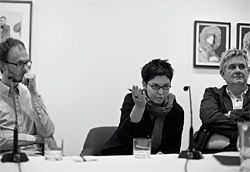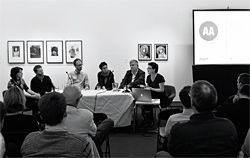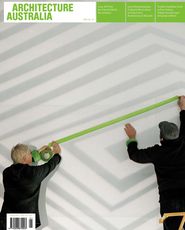The second AA Roundtable, held at the University of Queensland Art Museum. Panellists were: Dr John Macarthur (University of Queensland); Andrew Nimmo (Lahz Nimmo Architects); Marcus Trimble (SuperColossal); Lindy Johnson (HEAT Queensland), facilitated by Dr Naomi Stead (University of Queensland) and Justine Clark (then editor, Architecture Australia ). They considered the diverse roles that media can play in the development of architectural culture, and were interested in exploring publications, websites and other media as productive sites of engagement and exchange; to discuss how they might actively contribute to the development of the discipline rather than being simplistically understood as vehicles for self-promotion or as inadequate replacements for the “real” experience of visiting a building.
The event was framed by a series of broad questions – What is it for an architect to make a building available for public comment and critique? What’s possible in different contexts and different media? What is effective criticism? What are the responsibilities of the critic, architect, photographer, designer and editor? How might we understand the role of the reader or the viewer as an active participant in all of this? To begin, each panellist gave a brief account of their own involvement with the architectural media – what do they do and why?

Andrew Nimmo, Lahz Nimmo Architects. Image: Peter Bennetts

Marcus Trimble, SuperColossal. Image: Peter Bennetts

Lindy Johnson, HEAT Queensland. Image: Peter Bennetts

Dr John Macarthur, University of Queensland. Image: Peter Bennetts

Naomi Stead, with Marcus Trimble and John Macarthur. Image: Peter Bennetts

Overview of the panel: Lindy Johnson, Andrew Nimmo, Marcus Trimble, Naomi Stead, John Macarthur and Justine Clark. Image: Peter Bennetts
JOHN MACARTHUR
I’d like to say I make a contribution to architecture and the profession, but in some ways it’s the other way around – the profession makes a contribution to my credentials to teach architectural design. As someone with a career in the history and theory of architecture, my qualifications and credentials are all in the history of ideas. I also really value teaching architectural design, but to be involved in that world I need to be topped up regularly with the knowledge that comes from practising architects. So, while I hope I make a contribution by bringing together and distilling the things that architects tell me about their works, I often feel that I’m getting an education myself, and I can bring that understanding of what is happening in the profession back to the studio. That is what makes an architecture school quite different – it’s fantastic to be in a place where practitioners are being trained.
The critic has a role in making explicit a lot of things that are implicit in architectural knowledge. Architects have a lot to say about their buildings, but they’re often so involved in the making of the object themselves that there’s a role for someone else slightly external to that process to distil and make explicit. But for me, it is also about seeing how an architect thinks about the building and learning about architecture in that way myself.
MARCUS TRIMBLE
I run the office SuperColossal, a very small practice in Sydney. But I guess I’m here tonight because of the work I’ve done online. I started off with a blog called Gravestmor, when I was working at Bligh Voller Nield in Sydney, as an outlet for my thoughts. It was quite tongue-in-cheek, a bit satirical and I took the piss a bit. Reading it now it’s curious how slanderous some of it was. I was a recent graduate then and not part of the Sydney scene and so I felt I could say things that now I wouldn’t say. That website developed a bit of a following and so when I started my practice I wanted writing to be embedded in some way. So now our website has a blog. We approach our website in a different way from many other practices – it’s a company website but we publish the work of other architects and we point people away from our practice and try to develop a community of people. As a result I’ve been invited to contribute to more reputable publications such as Justine’s. For me there’s a very clear distinction between what I write for the blog and what I write for the journals, it’s a much more considered, well-informed type of writing.
And then finally, Twitter as a medium for architectural writing. A couple of weeks ago there was the Urban Islands Studio at Cockatoo Island, a fantastic studio that ran for two weeks and then an all-day crit out on the island. I was twittering as I sat through the reviews. And then half-way through I got a tweet from Justine saying, do you want to write about Urban Islands? So then I had to sit down and write that thing I had said yes to. This short-form writing and conversation is starting to develop through a new medium.
ANDREW NIMMO
I have a practice in Sydney with my partner Annabel Lahz, Lahznimmo Architects, so my principal engagement in life is running an architectural practice, which concentrates 02on public work. The first piece of writing I did was for the Architecture Bulletin about Luna Park. It had just been revamped and I was so disappointed that I wanted to find out what went wrong.
Sometimes writing an article is a way of forcing yourself to do research. They invited me to be on the editorial board of the AB. Then I got involved in Architectural Review Australia just as it was changing and trying to be more serious (I think it did a lot to improve Architecture Australia, which before Justine’s time had got a bit lazy and stale). Then I came to AA and I am on the editorial advisory committee. I don’t write a lot of articles, I principally write because I enjoy the craft of writing. It might be critiquing a particular piece of work or it might be a piece about the history of public housing in New South Wales. Writing an article gives you the discipline to explore something you are interested in.
In terms of why architects leave themselves open for critique, it is about promotion, I’m afraid. Most monographs are vanity publications; most magazines are promotional tools; the architect’s work has been chosen because someone likes it so they expect it to be positive. If it’s not positive then they’re a bit angry. You do get some people like John who actually write genuine critique but there’s not a lot out there. Probably the place to do it is in the non-architectural press – newspapers or magazines like The Financial Review or Newsweek. I’d like to see a lot more written about architecture in those sorts of publications.
LINDY JOHNSON
Now for something completely different. I manage the Creative Industries Unit within the Queensland Government. It’s the only unit of its type in Australia. It’s about increasing economic viability of creative industries – architecture, fashion, music, writing, publishing and visual art design. HEAT was conceived because architects do incredibly beautiful work in Queensland, but the world doesn’t know about it. HEAT is taking this talent to the world stage. We’ve already had really good results. HEAT was launched when my unit commissioned the Queensland Art Gallery’s exhibition Placemakers: Contemporary Queensland Architects. Independently curated, this showcased more than twenty Queensland architectural practices. I’m sorry to say it was the first time a national or state-run museum or gallery had ever held such a major architectural exhibition.
Secondly we went to the Venice Architecture Biennale. We invited the world’s media to come along and hear about our architectural talent and the response was overwhelmingly positive. The key message was: “Your story is incredibly authentic, but this is the first time we’ve heard about it.” We then engaged a very strategic media communications firm based in London and now we cannot keep up with the demand from journalists for Queensland architectural content. It’s going gangbusters.
For example the latest issue of The Architectural Review UK includes a major feature on Bark Architects, which came about through HEAT. We’ve hit $1.5 million in media over the last year. We’ve been published in more than thirty countries and the blogs and twitters are going crazy over us. We’ve had three leading international journalists here already, representing such titles as The Architectural Review, The Financial Times and ArchNewsNow.com. We are passionate about taking Queensland architecture to the world stage.
NAOMI STEAD Lindy, the success of HEAT has been spectacular. But, when you said that there’s been $1.5 million worth of media, how is that calculated? What price does one put on a critical review? Has any of the criticism been negative and how would you feel if it was?
LJ The quantifiable media tag is a standard industry formula – it’s based on the advertising rates that a particular journal or blog can attract, times the credibility factor. None of the criticism has been negative. If it was, bring it on. It’s really important to work within an international arena, so we’d love that debate. But it hasn’t happened yet. I think the international media are flummoxed by the beauty, they’re in seduction mode.
AN Lindy, you have taken a curatorial role to some extent – you’ve edited out a lot of stuff – so it’s not surprising that you have positive reviews. In Europe, pop star architects move from city to city winning the big, big commissions. Apart from Denton Corker Marshall I can’t think of an Australian firm who’s gotten into those really glamorous international commissions. Perhaps this could happen through the work you’re doing?
LJ And why not? If a Queensland firm doesn’t choose to work internationally, that’s fine, but I’d like them to have the option. At the moment your profile is just not there. Many people in the international arena say, “We love your work but we don’t know about it. If we knew more about it we’d be really interested in having a conversation.”
AN Is it also about their perception? Are they expecting beautiful crafted sheds in the countryside or on the beach and that’s as far as they look?
LJ They don’t know what to expect. I asked AR’s Rob Gregory that when I took him to Stradbroke Island to meet with Haig Beck, Bob Riddel and Brian Donovan. Rob said, “I don’t really know, because I’ve never thought about it before.” It was the first time all three journos had been to Australia and all of them said they were astounded by the quality of the work here but that we’re just not on their radar.
MT I think that perception is changing. The top project architectural blog is probably ArchDaily – they have five or six high-quality projects a day and there is a substantial representation of Australian work. Australian architecture is there on the websites.
JM I met Rob Gregory. We took him for pizza and told him about Queensland – he knew nothing much about it. But I’m interested in why international critics have such a role. One way is to see the critic as a conduit for transmitting the wonder of Queensland architecture. But don’t you think the quality of the discussion is also important, and that’s got to happen at a local level. If critics are always people who arrive on aeroplanes and then leave, it’s not going to make a culture here.
Returning to the question of why any of us would bother to write criticism. Everyone reads the magazine to see the photos and plans of the buildings, and they often turn to the text for two reasons. One is to read between the lines and see if this will be a three-and-a-half-star or a four-star level of praise and maybe to see some straight description, like gee the car parking turns are really very tight. But as a writer you also want to entertain, you want to engage the reader. I’d like to think that some people read the criticism to read the criticism.
AUDIENCE (PETER SKINNER) The thing I like about writing about architecture is writing to the architect. You’re intrigued by a piece of architecture. You don’t quite know why, so you think about it and try to write to that architect about what works and what doesn’t. My question is: when you’re putting a sentence down, who do you think it’s addressed to?
JM I also think I’m writing to the architect. I had the misfortune of being dobbed in by Justine to review the National Awards last year. Some time later I had a conversation with Carey Lyon, who said that when I’d described the Hume offices as what a commercial slab lot might look like if you’d dreamed it after a very rich dinner, they’d laughed outrageously around the office. I was very relieved.
AN It’s never occurred to me that I’m writing to the architect. I think of a mythical audience because I like the idea that someone will enjoy reading it.
JUSTINE CLARK Marcus, is there a difference in your writing for magazines like Architecture Australia and for the blog?
MT Absolutely. The blog is very hurried – I’m trying to get it out in the morning before I get started on some paying work. In that sense I am conscious of the audience because often it’s directing people to look at things, curating some body of interesting things.
NS What about your comment that when you started Gravestmor you were just out of uni and it was tongue-in-cheek, it was satirical?
MT Slanderous.
NS Slanderous, yeah. You’re not doing that anymore. Perhaps it’s because the people that you’re writing about are now your peers?
MT Yes, you’re right, but I don’t sit and imagine somebody reading it.
NS But you’ve become increasingly aware of the responsibility that comes with being a public critic?
MT Yes.
AN As a practitioner who writes occasionally I can pick and choose what I write, so I don’t write about stuff that I don’t like. I can think of a lot of buildings I’d love to write about but I can’t say what I really think, that’s the job for a journalist who can do that sort of thing.
AUDIENCE Do any of you write for a broader community? Because a lot of these buildings that you write about are public buildings. Is there any journalism that bridges the gap between the untrained and the trained?
MT I’ve written a few things for Dwell magazine, based in San Francisco, it’s a bit like Wired but for the built environment. I just finished writing an article for Voi Tutti, the Italian Chamber of Commerce magazine, a profile on architects in Sydney with Italian backgrounds. It’s interesting because I completely changed the way I approached writing that because it was going out to a non-architecture-based readership.
AN In the Sydney Morning Herald we’ve got Elizabeth Farrelly but nine out of ten times she’s doing social commentary – she rarely writes on architecture any more. If I retired from practice and didn’t have all the hassles of writing about colleagues’ work, I would love to write for something like Newsweek or The Bulletin. There’s a real gap there.
JC Often when architecture is talked about in the broader media it just turns into a fairly trite discussion about lifestyle, which does architects a disservice. I love the fact that Architecture Australia is for the profession – the profession is already a messy, complicated and very diverse audience – but there’s a huge opportunity for the architectural writer as public intellectual, partly to explain to the public what it is that architects do. The US, for example, has serious, established public critics – the newspapers commission engaged writing on architecture as they commission good and engaged writing on other topics. That’s something which could certainly be developed more here.
NS One very interesting example of popular architectural criticism is the TV program Grand Designs.
JC Yes, it shows there is a huge interest, but as a profession we haven’t yet figured out how to access that and communicate effectively.
LJ I want to read more in the mainstream press about our creatives. But I don’t want to hear their recipes – I want to hear about their ideas. We need more of it. In response to the question, we actively pitch to The New York Times, The Wall Street Journal, The Financial Times. We’ve got major features in them and we want more. We’re actively courting the high-end mainstream press, which is key to influence.
AUDIENCE What’s missing for me is a conscious effort to put a frame around what you’re presenting – you talk about criticism and critique as if they’re the same thing. I hear a discipline that’s trying to put together practice with debate about theory and frame all of them in a way that the outside world can understand. You’ve a big job here, a huge job.
JM You’re right, we lack that broad base by which the profession’s view of itself and, however tame, of its own faults can be understood by a broader public. It relates to Justine’s comment about it being extremely difficult in this country to publish adverse criticism. We’re not going to change libel laws in this forum. But I think the best way to loosen their grip is in what we’re just talking about – increasing the breadth of architectural discussion in the public media. You could see the force of the libel laws when architecture was largely published in property pages. As it moves across the lifestyle pages and maybe eventually hits the culture pages, it will come to be seen more as an object of cultural investment. Maybe then we’ll see some sort of convergence in space where you can have that kind of critique.
AUDIENCE (GREG BAMFORD) It seems less common now to have a review with multiple perspectives and to concentrate on other aspects of a building. Sometimes we could take off our hats and say we’re not going to talk about this as a piece of architecture, we’re going to talk about it as something else. And then other times people should feel free to talk about it in purely aesthetic terms and ignore the fact that the children in the classrooms are baking or whatever.
JC I think again it’s partly because so many projects are published only once, so the writer feels an obligation to try and cover all the ground. But for me the best pieces of writing are often those where the writer brings their own particular knowledge and experience to bear on that building and allows us to see that project in particular ways. It is great to have multiple views on buildings in one publication, but it’s about the constraints of space. That can change as we move into other media.
AUDIENCE (SHANE THOMPSON) I’m curious about this idea that architects are some sort of protected species in cultural criticism. In my experience architects aren’t afraid of criticism. The criticism doesn’t seem to be tough enough, and I can’t see that that can simply be put down to the litigiousness of architects. Is that really the case?
JC No, I don’t think architects are frightened of criticism, but mostly they’d like more criticism of others. Although that’s not entirely true. I really think the community polices itself – I have never told a writer they can’t say something because it is too critical.
ST So why are the writers so concerned to hold back, as you and others seem to think that they obviously do?
NS There is an analogy to food criticism. Food critic Terry Durack comments that the audience for restaurant reviews is very much like Parisians sitting close to the guillotine. We could say the same about architecture – which puts the critic in the position of executioner.
ST I’m not suggesting it needs to be that extreme, but, like many others in the room, I’m used to reading criticism all the time – book criticism is the most significant type. And I don’t quite understand the difference between what you read there and what you read about architecture. There’s a position taken about whether the critic liked the work or not or thought it had value or not, thought it contributed to the culture of writing in the country or not, and whether it was worth reading or not.
JM In my short career as a critic I have had my boss rung up and questioned if my career should be continued at the university and threatened with solicitors’ letters and so on. But there is another issue which is about the genre of criticism. When I first started there was an expectation that people like me would decorate a project with some sort of theoretical, impenetrable ornament that was difficult to read. In that genre of writing, one didn’t make judgments – it was a critical culture that didn’t come down to criticism in the sense of judgment. Now that moment has changed. I think a level of judgment is fundamental to a critical mode of writing.
AUDIENCE (PS ) Can I ask about another genre – absolutely outraged writing? There are terrible things being done to our cities; this city is being carved in half by roadworks and tunnels that are breaking down any previous perception of how the city worked. When something makes you angry it is very difficult to find a vehicle for writing about it.
AN Letters to the editor are an opportunity for that. When I was on the editorial committee of the Architecture Bulletin I used to try and instigate letters on certain topics just to get debate going. Sometimes you could do it but sometimes when people cool down they’ve lost interest.
To return to Shane’s question, I think architects want endorsement. If you’re getting endorsement from someone like John or Naomi, that feels pretty good. But say if I wanted John to write a piece about one of our works and he came to me and said, “Look, are you sure you want me to write? I had a look at it and it is a real dog”, I’d probably have second thoughts. I’d be interested in having a chat with him and getting that critique one-on-one, but as someone running a business there’s no benefit for me in a really tough critique in the public realm.
ST I guess that goes back to my earlier question about why are architects such cultural outsiders compared to other cultural activities. Certainly musicians and others get pissed off about a bad review but they’ve got to take it as part of the game. I have a sense that maybe the days of hiding your work and suppressing your work are long gone.
JM I think that comes back to the distinction between a discipline and a profession. Architecture has historically modelled itself on a profession, such as the medical or legal professions – you don’t hear a lot of medicos or lawyers admitting to their mistakes or that kind of criticism. There’s a balance between the sense of a profession as a licensed and closed shop and a discipline, which has an open public debate.
AUDIENCE We’ve had a lot of discussion about text but a large part of the architecture media is photographs. How important is the role of photography and what improvements could be made?
JC Photography is absolutely vital. The first improvement would be to wait a bit longer before the building is photographed. Far too many buildings are photographed too early – before anyone has moved in, before the landscape has grown or the building has “settled”. The photographer brings another interpretive eye – as an architect you are opening your work to someone else’s interpretation when you get it photographed. Photography is expensive, so you usually only get one set of photographs of a building in the public realm. I think it would be great to have a wider range of photographic interpretations of projects.
AUDIENCE (PETER BENNETTS) Architects have often been waiting a hell of a long time for their buildings to be finished and photographed, so there are the pressures to get it out there. Of course we all know that architecture is not experiential – it’s about how it looks once it’s photographed and published. Most of us experience most architecture in this way. It’s a very rare privilege to get into a private residence, and how many of us have seen the sun rise over the Barcelona Pavilion – well, the photographer generally has. In terms of criticism – let’s not complain about what’s been written, let’s get out there and write it!
Finally, it’s as much what you don’t photograph as what you do.
JC But we don’t see what you don’t photograph.
PB No, but I’ve walked around the back and I can tell you there’s nothing there.
AN I’ve written articles on residential work where you’re meeting with the architect and the owner at the same time and I am amazed at how stage-managed some photo shoots are. We’ve been guilty of that too. We couldn’t afford decent furniture in a place, then you talk to a company you’re friendly with and they bring it in for the day and it looks a million dollars, and off it goes again.
JM One of the interesting things about photography is that Justine says it’s expensive and I guess it is, but it’s actually also incredibly cheap. I don’t read a lot of architecture blogs but gee I use Flickr. Images are now so ubiquitous – what you can get from Google street view or Google Earth or Flickr is astonishing. That changes the value of the photographer’s art – it doesn’t devalue it, it makes people more aware of what art there is in photography as opposed to the vernacular use. Of course there’s an interesting crossover between vernacular and professional photography, but that’s changed quite a lot given the cost of full colour printing, and the fact that you can download these things in seconds.
AUDIENCE The fantastic thing about the print media is the spreads, but you can’t get people’s responses. In the online world, the vigorous debate after something is posted is really interesting. Maybe that’s a way for the architecture profession to make that link to the public?
JC Blogs are fascinating, partly because they give you the sort of access to what readers think that you used to get only if you happened to be at the right dinner party. That casual and immediate response is fantastic and very different from what a magazine offers and I think they’re complementary. But some get hijacked by pretty venal, nasty participants – comments that would once have been kept to bars and dinner parties.
MT Our blog isn’t very heavily commented on because it doesn’t have the enormous readership that some have. Someone like Geoff Manaugh, of BldgBlog – a lot of his posts get thirty or forty comments, there’s a discussion taking place and some general posts will be educated and quite informed. But if one of his posts gets picked up by Digg or Reddit you get 100,000 people and the conversation degenerates and misses the point and you can see Geoff in the comments trying to direct the argument back …
AUDIENCE How do we feel about the amateur person with the uneducated view of our buildings?
MT I think the whole idea of criticism relies on that gradient, it is based on a sliding hierarchy where you suppose that the person writing is more expert than the person reading. Of course it’s completely reversible because the less-expert person is the “every person” whom the critic is trying to persuade. So the whole social game of being involved in criticism and reading it and writing it, I guess, is assuming there are degrees of expertise even though everybody knows that can never be proven. I think that’s part of the social enjoyment, you need to imagine that every person has a complete and unprejudiced attitude to the object.
AA Roundtable 02 was held on 14 August 2009 at the University of Queensland Art Museum (in conjunction with the Writing Architecture Symposium). Thanks to the event hosts, the Art Museum and sponsors – the University of Queensland School of Architecture and the Queensland Government’s HEAT initiative.















